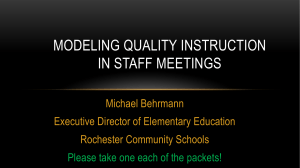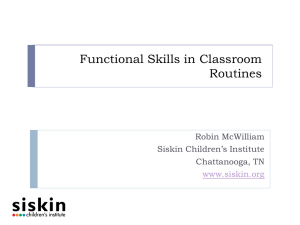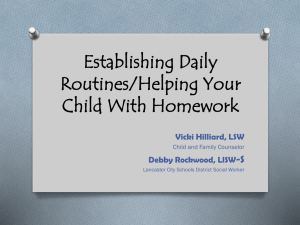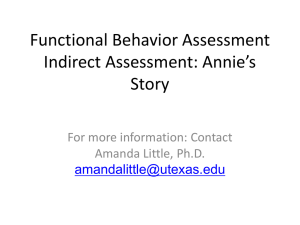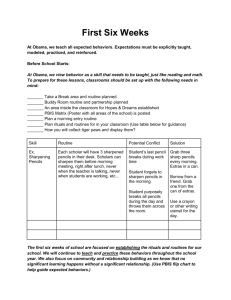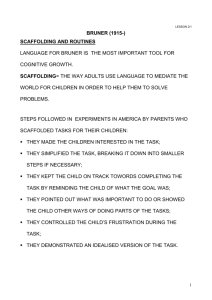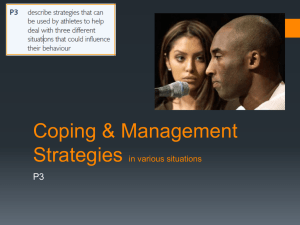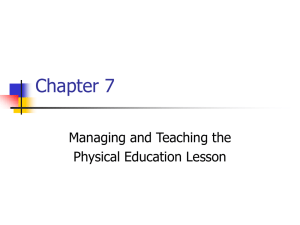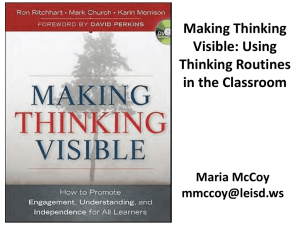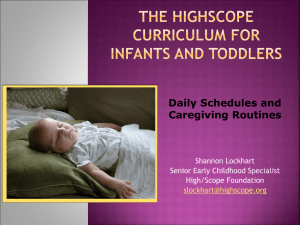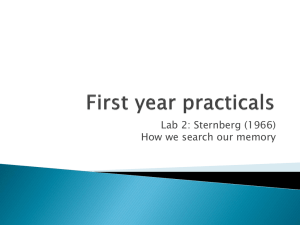Classroom PBS Workshopprt1 (1)
advertisement
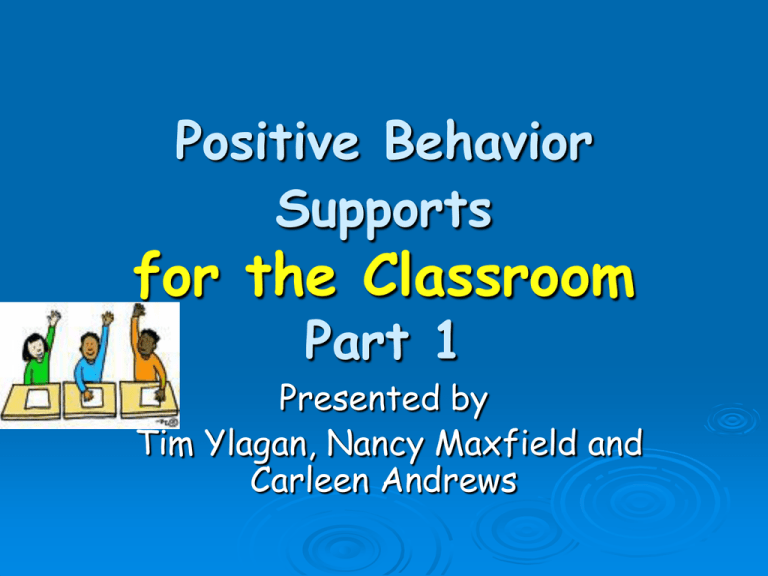
Positive Behavior Supports for the Classroom Part 1 Presented by Tim Ylagan, Nancy Maxfield and Carleen Andrews Overview Brainstorm-Introductions What is PBS? Classroom Systems Brain Break - 4 Corners Pair Share-Classroom Routines Matrix More Classroom Systems Reflect Brainstorm Effective classroom management… PBS Basics Positive Behavior Supports (EBS/PBIS) Based on the Behavioral Model Is evidence based practice Systems Approach It about building effective classroom management Connection Research suggests that students who feel connected (enjoy going to school, like their teachers & fellow students) have fewer behaviour issues, greater emotional well being (Eccles, 1993) and better academic outcomes (Osterman, 2000) Relationships “The quality of the teacher/student relationship is the single most important factor to consider when rethinking classroom management” Patricia Sequeira Belvel & Maya Marcia Jordon Relationships and PBS Positive • • Relationships are: The foundation of any classroom-based approach to positive behaviour Key to creating a safe and caring classroom climate that invites/supports positive behaviour and skilled problem solving Alberta Ministry of Education School-Wide PBS Levels of Intervention Classroom 1. Classroom-wide positive expectations taught 2. 3. 4. 5. 6. & encouraged Teaching classroom routines & cues taught & encouraged Ratio of at least 4 positive to 1 negative adult-student interaction Active supervision Design a Functional Physical Layout for the Classroom Maximize Engaged Academic Time Brain Break 4 Corners 1. What percentage of students in a classroom would typically respond to green-zone interventions? A. B. C. D. 80% 15% 5% 75% What is the recommended ratio of positive to negative adult-student interactions? 2 to 1 B. 3 to 1 C. 4 to 1 D. 7 to 1 A. 3. Classroom behaviour expectations should look like… A. C. B. D. 1. Behavioral Expectations Define and teach 3-5 expectations for your classroom early in year. Positively stated expectations Easy to remember Posted in the classroom Consistent with School-wide rules/expectations Taught Directly Positive and negative examples Rights, Respect and Responsibilities Reflect 2. Classroom Routines Define and teach classroom routines How to enter class and begin to work How to predict the schedule for the day What to do if you do not have materials What to do if you need help What to do if you need to go to the bathroom What to do if you are handing in late material What to do if someone is bothering you. Signals for moving through different activities. How to determine if you are doing well in class Establish a signal for obtaining class attention Teach effective transitions Designing Classroom Routines Routine Desired Behavior Signal Entering Class Walk in, sit down, Instruction on board start work Bell Activity Obtaining class attention Orient to teacher, be quiet ? Getting Help during seat work ? ? Small Group Activity: 5 min Identify Routines Pick a different routine common across classrooms in your school. Complete the matrix for your classroom. How do you share and find out good strategies in your school? 1-min reports. Classroom Routines Matrix Routine What do you expect? What is the signal? Steps for Teaching a Routine Explain Demonstrate/Model Guided Practice Perform Independently Review/Re- teach Cool Tools Teach Students to SelfManage Once students know the routines, allow routine initiation to be prompted by normal events (the bell… completion of an assignment)… rather than rely on teacher prompts. Teach self-management The target behavior The self-management behavior Prompts Consequences 3. Establish a “positive environment” (4-1)At least four instances of positive interaction for every correction. Begin each class period with a celebration. Your first comment to a child establishes behavioral momentum. Engelmann, Mace, “interspersed requests” Provide multiple paths to success/praise. Group contingencies, personal contingencies, etc 4. Active Supervision Move Interact Acknowledge Proximity makes a difference Redirections for minor, infrequent behavior errors Frequent pre corrections for chronic errors 5. Design a Functional Physical Layout for the Classroom Different areas of classroom defined for different activities Define how to determine “what happens where” Traffic patterns Groups versus separate work stations Visual access Teacher access to students at all times Student access to relevant instructional materials Density Your desk Reflect and Share 1 thing to try this week PBS view of the class Positive Behavior Supports for the Classroom Part 2 Presented by Karen Gonzales and Tim Ylagan Classroom Pt. 2 6. Maximizing academic engagement time 7. Ensure academic success: match curriculum to students’ skills 8. Vary modes of instruction 9. Establish an effective hierarchy of consequences for problem behavior 10. Teacher has a system to request assistance 6. Maximize Academic Engagement Time Plan for transitions Maximize opportunities for student responses Active supervision Pacing Student feedback Planning and engaging students with disability ie Autism 7. Ensure Academic Success match the curriculum to students skills Academic failure leads to problem behaviour. How can we teach with success and still teach the required curriculum? Monitor and adapt Maintain instructional objective, but adjust the curriculum/instruction Curricular adaptation (strategies) Have fun 8. Varying the Modes of Instruction Group lecture Small group Independent work Integrating Activities Peer tutoring 9. Establish an effective hierarchy of consequences for problem behavior Do not ignore problem behavior (unless you are convinced the behavior is maintained by adult attention). Establish predictable & reasonable consequences Establish individual consequences AND group consequences 10. Teacher has System to Request Assistance Teacher should be able to identify need for assistance and request help easily. Does your school have a form for requesting help? How do you initiate the identification process for students needing extra support. • School based resource people • District resource people • Provincial resource programs/outside agencies Classroom 1. Classroom-wide positive expectations taught 2. 3. 4. 5. 6. & encouraged Teaching classroom routines & cues taught & encouraged Ratio of at least 4 positive to 1 negative adult-student interaction Active supervision Design a Functional Physical Layout for the Classroom Maximize Engaged Academic Time Classroom Pt. 2 6. Maximizing academic engagement time 7. Ensure academic success: match curriculum to students’ skills 8. Vary modes of instruction 9. Establish an effective hierarchy of consequences for problem behavior 10. Teacher has a system to request assistance
